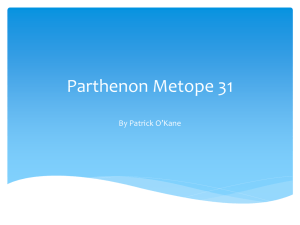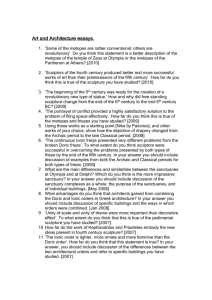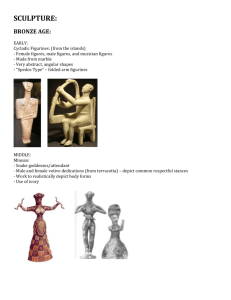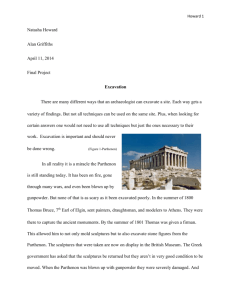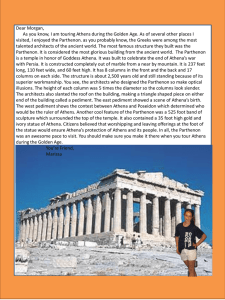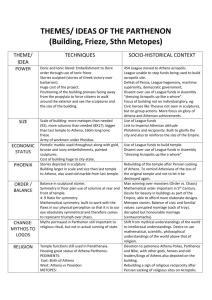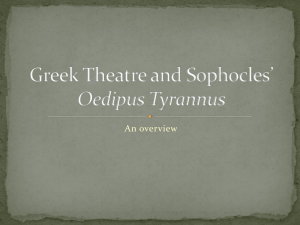centauromachy - Astro*Synthesis
advertisement
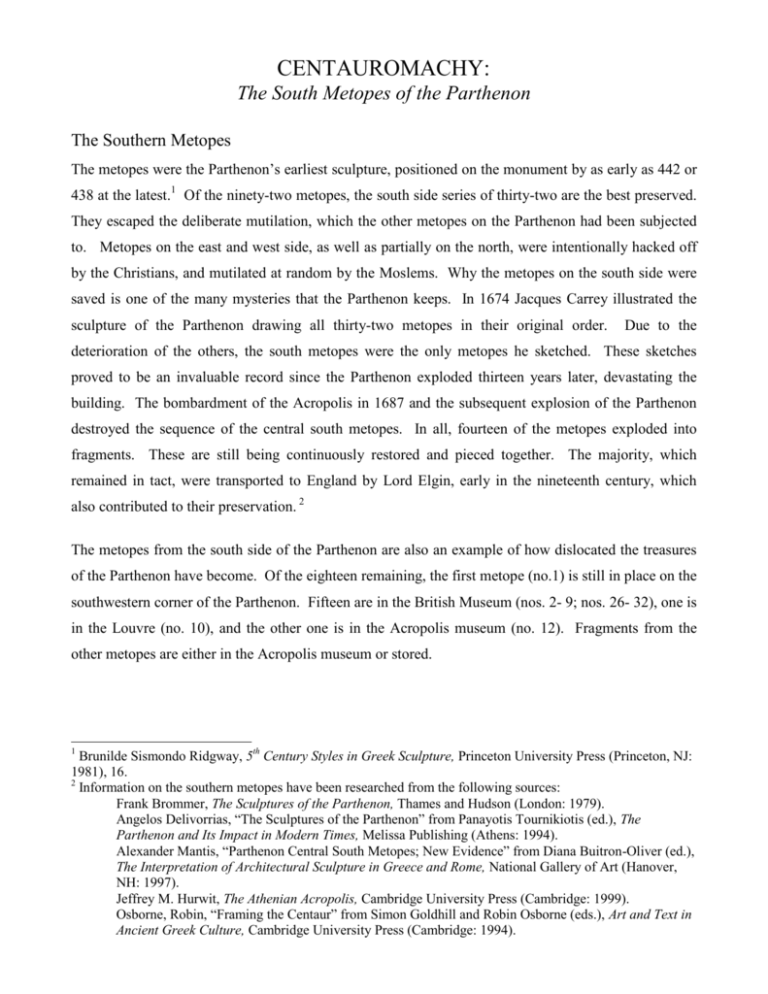
CENTAUROMACHY: The South Metopes of the Parthenon The Southern Metopes The metopes were the Parthenon’s earliest sculpture, positioned on the monument by as early as 442 or 438 at the latest.1 Of the ninety-two metopes, the south side series of thirty-two are the best preserved. They escaped the deliberate mutilation, which the other metopes on the Parthenon had been subjected to. Metopes on the east and west side, as well as partially on the north, were intentionally hacked off by the Christians, and mutilated at random by the Moslems. Why the metopes on the south side were saved is one of the many mysteries that the Parthenon keeps. In 1674 Jacques Carrey illustrated the sculpture of the Parthenon drawing all thirty-two metopes in their original order. Due to the deterioration of the others, the south metopes were the only metopes he sketched. These sketches proved to be an invaluable record since the Parthenon exploded thirteen years later, devastating the building. The bombardment of the Acropolis in 1687 and the subsequent explosion of the Parthenon destroyed the sequence of the central south metopes. In all, fourteen of the metopes exploded into fragments. These are still being continuously restored and pieced together. The majority, which remained in tact, were transported to England by Lord Elgin, early in the nineteenth century, which also contributed to their preservation. 2 The metopes from the south side of the Parthenon are also an example of how dislocated the treasures of the Parthenon have become. Of the eighteen remaining, the first metope (no.1) is still in place on the southwestern corner of the Parthenon. Fifteen are in the British Museum (nos. 2- 9; nos. 26- 32), one is in the Louvre (no. 10), and the other one is in the Acropolis museum (no. 12). Fragments from the other metopes are either in the Acropolis museum or stored. 1 Brunilde Sismondo Ridgway, 5th Century Styles in Greek Sculpture, Princeton University Press (Princeton, NJ: 1981), 16. 2 Information on the southern metopes have been researched from the following sources: Frank Brommer, The Sculptures of the Parthenon, Thames and Hudson (London: 1979). Angelos Delivorrias, “The Sculptures of the Parthenon” from Panayotis Tournikiotis (ed.), The Parthenon and Its Impact in Modern Times, Melissa Publishing (Athens: 1994). Alexander Mantis, “Parthenon Central South Metopes; New Evidence” from Diana Buitron-Oliver (ed.), The Interpretation of Architectural Sculpture in Greece and Rome, National Gallery of Art (Hanover, NH: 1997). Jeffrey M. Hurwit, The Athenian Acropolis, Cambridge University Press (Cambridge: 1999). Osborne, Robin, “Framing the Centaur” from Simon Goldhill and Robin Osborne (eds.), Art and Text in Ancient Greek Culture, Cambridge University Press (Cambridge: 1994). The southern metopes seem to consist of two separate mythological cycles. The first twelve and the last eleven metopes are images from a centauromachy, a battle with Centaurs.3 The consensus is that this particular Centauromachy represents the battle of the Centaurs against the Lapiths, which occurred at the wedding of Pirithous to his bride, Hippodamia. These two groups of metopes flank the central ones. Since these were destroyed in the explosion and Carrey’s drawings do not provide enough detail, the narrative of the central metopes cannot be identified with certainty. However, it is clear that the iconography of these nine metopes do not match the scenes of the Centauromachy on either side. Fragments continue to be assigned to the middle metopes, which help to refute previous interpretations, yet this work has not been able to yield a positive identification of the mythological theme.4 The central metopes remain ‘an enigma’5. Some of the Thirty Two Metopes from the South Parthenon 3 The context of the narrative on Metope 21 is puzzling. A possibility is it may belong to the battle of the Lapiths and the Centaurs. If so then the sequence becomes more symmetrical since twelve metopes are on both sides of the central sequence would belong to the Centauromachy. See footnote 27. 4 Alexander Mantis, “Parthenon Central South Metopes; New Evidence” from Diana Buitron-Oliver (ed.), The Interpretation of Architectural Sculpture in Greece and Rome, p.67. 2 The possible interpretations for these middle metopes vary as to whether they depict an Attic (or Athenian) or another Greek mythological cycle. There has been speculation whether they represent an unknown local Attica myth or portray episodes about Athenian genealogy, with Erichthonios, Erechtheus and members of the Kekrops’ family. Other mythological themes suggested have included Ixion, Daedalus and Phaedra and Alceste.6 In order to view the thirty-two metopes sequentially it has been proposed that the centaur battle could be an unknown Attic Centauromachy with the central metopes being an episode from Attic myth. In this arrangement the complete series of southern metopes would be unified thematically by a local legend.7 However the metopes would also be coherent if the myth of Ixion, the Lapith king, were the mythological narrative in the central episode framed by the Thessalian centauromachy. The lack of unified theme is also reflected by the actual sculpture variant in form and style. The craftsmanship of the south metopes is irregular. Scholars suggest that the standard of the sculpture covers a wide range of styles and expertise since the ‘carving of each metope had been assigned to an individual artist’.8 While there are some stylised Centaur metopes ‘some are weak, some very weak,9 suggesting the differing levels of expertise of the craftsmen involved. This variance has created speculation about the original intention of this sequence. A suggestion has been made that some of the metopes were intended for an earlier Kimonian temple, dating the style to an earlier severe period.10 However there are important iconographical themes inherent in the Centauromachy, which resonate with other images on the Parthenon and designed as part of the overall building program. The Centauromachy symbolises the conflict with the barbarian who savagely violated traditions and customs revered by the Athenians. This continuous struggle with forces outside the polis is a theme that is coherent with other scenes on the Parthenon’s sculpture. 5 Jeffrey M. Hurwit, The Athenian Acropolis, p. 173. Angelos Delivorrias, “The Sculptures of the Parthenon”, p. 19 7 Frank Brommer in The Sculptures of the Parthenon, p. 24 states: ‘to me it seems more probable that the whole row depicts a single subject, and that therefore the centauromachy relates to a local Attic legend like the middle section.’ 8 John Boardman, The Parthenon and Its Sculptures, p.33. For further discussion see 8 Jeffrey M. Hurwit, The Athenian Acropolis, p. 174 and Robin Osborne, “Framing the Centaur”, pp. 72-5. 9 Martin Robinson, “The Sculptures of the Parthenon” from G.T.W. Hooker (ed.), Parthenos and Parthenon, Oxford University Press (Oxford: 1963). 10 Ridgway, Brunilde Sismondo. Fifth Century Styles in Greek Sculpture, p. 16. 6 3 Centauromachy: Culture vs. Nature The Athenians were forced to evacuate their city in 480 because of the Persian invasion. In 479 they returned to be confronted with the complete devastation of their city. While the Athenians cleaned up, not all the debris from the sack of their city was buried. Broken statues, smashed pottery and architectural ruins were left scattered on the Acropolis to serve as a visual reminder of ‘the impious barbarians who had ravaged their sanctuary’11. The images of the plunder and destruction of their city had been indelibly impressed upon the Athenian psyche. This imprint found expression through the image of the barbarian12, the ‘other’. An appropriate mythic figure to represent the barbarian was the Centaur, a marginalised creature that lacked respect for the ways of the polis, transgressed boundaries and savagely assaulted humans. Therefore the Centauromachy was also a congruous mythic scene which encapsulated the struggle with barbaric forces. This reminded Athenians of their struggles with barbarians, which the war against the Persians had first exemplified. The battle with the Centaurs also portrayed the continual conflict of opposites: culture/ nature, civilised/savage, man/beast etc. By the middle of the 5th century the experience of the barbarian had influenced the way the Athenian conceived of the ‘other’. This 5th Century principle of polarity is often demonstrated by contrasting the extremes of sophrosyne versus hybris. Moderation and self-restraint (sophrosyne), an Athenian attribute, was a polar opposite to the lack of moderation and impiety (hybris) of their enemies (i.e. the Persians and other barbarians).13 This tension of opposites is defined clearly in the metopes by the individual duels between Centaurs and Lapiths. The antagonists are equally balanced, stressing the tension of their struggle. By the 5th Century the image of the Centaurs ‘are all over fifth-century public sculpture’14. By contrast the theme of the Centaurs in the archaic period had little impact on Greek public sculpture.15 During the 5th century the narrative of the Centauromachy was not only used for the southern metopes of the Parthenon, but also utilised on the western pediment of the temple of Zeus at Olympia and the frieze on the temple of Apollo at Bassai. This battle motif was also used on the friezes for the temple of Poseidon at Sounion and the temple of Hephaestus in the Agora. The Centaur was a representative of the ‘other’ and a figure onto which the Athenian could project the barbarian. The proliferation of this 11 Jeffrey M. Hurwit, The Athenian Acropolis, p. 142. See Edith Hall, Inventing the Barbarian, Clarendon Press (Oxford: 1989). Her thesis suggests the image of the barbarian came into the Athenian consciousness after the invasion of the Persians. 13 David Castriota, Myth, Ethos and Actuality, University of Michigan (Madison, WI: 1992), p.17ff. 14 Robin Osborne, “Framing the Centaur”, p. 81. 15 Ibid, p. 81. 12 4 motif suggests how the consciousness of the 5th century Greek had been impacted by the experience of the barbarian. Aischylos, in 472 BCE, produced his play the Persians. He condemned the Persians on moral, ethical and religious grounds. Aischylos’ voice confirmed that ‘the Athenian rationale for the victory over the barbarians had already begun to take shape’.16 This ‘victory over the barbarian’ was a theme visible on the Parthenon’s sculptures. Athena Parthenos held Victory in her right hand, a celebration of the outcome of the battle against the hybristic enemies of Athens. This struggle was not only reflected by the Centauromachy metopes, but also in the western metopes, depicting the battle with the Amazons, and the eastern ones portraying the battle of the Gods and Giants. The metopes stressed the conflict, not the victory. The Parthenon’s southern metopes portrayed the precariousness of this struggle. While the tension between the Lapith and the Centaur is stressed there is often no clear winner. The commemoration of the conflict with (not necessarily the triumph over) the forces antithetical to the polis was ‘at the core of the Acropolis’s imagery’17. The Parthenon was the masterpiece of the Periclean building project funded by the Delian League. Under Pericles’ leadership Athens’s power and prestige grew through imperialism and democracy. Since the Persian invasion and the foundation of the Delian League, Athens domination of the Aegean and beyond had increased. Its imperialistic tendencies sparked conflict with other Greek cities. While the Parthenon was being constructed the ‘other’ was no longer just the Persians, but all aggressors of Athens. Democracy and the role of the citizen were also important for Athens during this period. The Athenian respected their democratic values of order, justice and moderation, which had been gained through conflict. Conflict had been essential in defining and sustaining these values of the polis and its citizen body. Viewing the sculpture on the Parthenon, the visitor could remember how the Athenian spirit was galvanised at Marathon in the conflict with the Persians. Battling with the Centaur represented the many aspects of these struggles with the barbarian and the positive outcome of the conflict. Centaurs were marginalised creatures: wild, unpredictable and barbaric, brandishing tree trunks, boulders and firebrands as their weapons. They inhabited a threshold between the primitive past and 16 David Castriota, Myth, Ethos and Actuality, p. 23. The image of the barbarian is an important image in the construction of the Parthenon and later in this book David Castriota suggests that the Parthenon would have been understood as a symbol ‘for Athens’s continued vigilance against the barbarian’ (page 137). 17 J. Hurwit, The Athenian Acropolis, p.231. Page duBois, Centaurs and Amazons, Women and the Pre-History of the Great Chain of Being, p. 63 suggests that the fixed and static representations of the centaurs on the metopes suggested their exclusion ‘from the origins and from the present reality of Athens’ since they had no power of movement. 5 the civilising present. The Centaurs were creatures who lived on the margins, foreign to the polis: ‘creatures at the boundaries of difference’18. They were hybrids, instinctual, intolerant of culture and disrespectful of its laws and customs. Page duBois summarises the image of the Centaur as representing the pre-cultural past. the Centaurs inhabited a threshold, were liminal in another sense, that is, they lived in nature both as violent, uncivilized beasts, and as characters from a lost past, before the necessity for separation between gods and men, before work, cooking, death, all the evils that culture brings. They demonstrate the Greek’s fundamental ambivalence about nature and the prehistory of mankind. The world before culture was viewed with nostalgia as well as loathing.19 This ‘world before culture’ was epitomised by the Centaur; he symbolised anti-culture, as did the Amazons and the Giants. The Centaur symbolised the chaos beyond the ordered convention of Athenian life. Marriage was a valued convention of Athenian culture and it is a theme reiterated on the Parthenon sculptures. On the southern metopes marriage was being defended ‘against bestial and promiscuous sexual activity’20 represented by the Centaurs. The Centauromachy was ignited at the marriage feast of Pirithous and Hippodamia.21 In this myth the Centaurs violate the sanctity of marriage by attempting to abduct the bride, as well as carry off other Lapith women. The abduction of women is shown in six of the metopes: numbers 10, 12, 22, 25 & 29. Centaurs are anti-marriage and consistently violate the custom of gift-exchange22, aspects of the barbaric temperament, which needs to be subdued. The myth of Ixion as the middle section of this sequence of metopes would be consistent with this theme since he also violated the sanctity of marriage by attempting to seduce Hera, the goddess of marriage and the wife of Zeus. Not only was he the father of Pirithous but also the grandfather to the Centaurs. Believing he was mating with Hera, the goddess of marriage, Ixion impregnated Nephele, conceiving 18 DuBois, Page, Centaurs and Amazons, Women and the Pre-History of the Great Chain of Being, p. 27. Page duBois, Centaurs and Amazons, University of Michigan (Ann Arbor, MI: 1991). p. 30. 20 Sue Blundell. “Marriage and the Maiden: Narratives on the Parthenon” from The Sacred and the Feminine in Ancient Greece (London: 1998), p.58. 21 Sue Blundell. “Marriage and the Maiden: Narratives on the Parthenon” on page 58 reports that before the 5th century the marriage feast and the fighting were portrayed as two separate, yet causally linked, events. Locating the fighting at the scene of the wedding was a 5th century addition. The south metopes were emphasising the theme of marriage and the barbaric forces, which opposed the institution. 22 There is one exception. Chiron is a centaur who is married. However Chiron’s lineage is different that the other centaurs, being a son of Chronus and Philyra. His temperament is also antithetical to the others as he is wise and just, a mentor, healer and philosopher. 19 6 Centaurus who was the father of the Centaurs.23 The north metopes depicted the Trojan War, a battle that erupted due the abduction of a bride, Helen, and her broken marriage. The Amazons on the western metopes also were barbaric women who rejected marriage. On the east frieze Hera lifts her veil like a bride while Pandora, the first mortal bride, is on the base of the statue. The Centaurs depict forces destructive to the social customs of the polis and their violation of the institution of marriage is a theme underlying other sculpture on the Parthenon. This centauromachy also suggests another tradition has been violated: the custom of xenia, guest friendship. They have violated festivity, disrespected hospitality, and betrayed relations with their own kind (in Pindar’s version of the myth they are related to the Lapiths). Centaurs are lustful, bestial, and incapable of controlling themselves. They become enflamed with the smell of alcohol and are unable to be contained.24 As half man, half beast the Centaur symbolised the boundaries between man and beast, culture and nature, control and chaos. It was these polarities which the visitor would be reminded through the unity of themes in the iconography of the Parthenon. Iconography: Citizen versus Barbarian Mid 5th century Athenians were influenced and stimulated by images from a variety of mediums: poetry, epic, myth, play and sculpture. ‘Of all Greeks, the Athenians especially lived in a world of icons, and the associations evoked by an image were the same as those evoked by a story, poem, or play and far more immediate’.25 Mythic narratives, which promoted Athenian ideals and celebrated its achievements and supremacy, were told through the iconography of the Parthenon. Although a myth will change over time, the Parthenon sculpture was created in a defining moment of Athenian history and its iconography reflects this. The visitor viewing the metopes on the south side of the Parthenon would also glimpse passages on the frieze, framed by columns. The frieze would also be partially hidden from view. To fully appreciate the frieze the visitor would have to move inside the colonnade.26 The movement of the south frieze is from left to right. The procession of sixty horsemen, ten chariots, elders, musicians, and attendants leading ten sacrificial cows moves towards the east side where the procession culminates with the gathering of the gods. Through the open doors on the eastern side the visitor would also see the 23 Pindar, The Odes of Pindar, translated by C.M. Bowra, Penguin (London: 1969), Pythian II: 21-48. For amplification on these points see G.S. Kirk, Myth and Its Meaning and Functions in Ancient and Other Cultures, Cambridge University Press (Cambridge: 1986), pp. 152-62. 25 John Boardman, The Parthenon and Its Sculptures, p. 22. 26 For a discussion on how the ancient visitor to the Parthenon may have viewed the sculpture see Jeffrey M. Hurwit, The Athenian Acropolis, pp. 179-81. 24 7 magnificent chryselephantine statue of Athena Parthenos inside the cella. The Centauromachy motif on the sandals of the goddess would remind the viewer of the iconography on the south metopes.27 Two Horsemen of the Parthenon Frieze The horsemen on the south frieze are in stark contrast to the horse/men on the metopes. Their procession is ordered, coherent, contained by the rituals of the festival, which they are celebrating. They respect the festivity unlike the Centaurs who are chaotic, aggressive and have violated the festivity of the marriage ritual. Battle for the Centaurs is wild and unpredictable fought with random weapons like the amphora (or hydria) the centaur wields in metope 4. This inimical method of warfare contrasts with the hoplite and the Athenian’s approach to battle. Sacrifice to the gods is also suggested on the south frieze with the inclusion of the ten cows being led to the east side where the gods are gathered. The motif of sacrifice suggests the separation of gods and men and the respect for the boundary between human and divine. This religious ritual is an aspect of culture, which reflects the moderation and modesty of the human petitioning the divine forces for their blessing. In contrast the Centaurs were violent, primitive, and existed before ‘the necessity for separation between gods and men, before work, cooking, death, all the evils that culture brings.’28 27 J. Hurwit, The Athenian Acropolis, p. 228 also says that this motif of the battle of the Centaurs and the Lapiths was added to the surface of the shield on the older bronze statue of Athena. Hence the continuity of the centauromachy was evident on the Acropolis. 28 Page duBois, Centaurs and Amazons, Women and the Pre-History of the Great Chain of Being, p. 30. 8 The incompatibility between culture and nature was a theme that had already impressed the visitor. Their first view of the Parthenon would have been the west pediment where the myth of Athena and Poseidon competed in a contest for Athens. Athena, a culture goddess and the embodiment of Athenian culture, was triumphant over Poseidon, a nature god inclined towards vengeance and chaos. On the western metopes the battle between the Amazons and the Greeks also reinforced the polarity of culture/anti-culture. Like the Centaurs, the Amazons were also antagonistic to marriage, rejecting the conventions of the polis. The image of the horse is also used in a complex of associations. Poseidon was associated with horses29, whereas Athena had given man the bridle to tame the horse. Amazons, warrior women, rode horses, which violated convention. Centaurs were hybrids of man and horse, born of the cursed union between Centaurus and the Pelion mares, while the horses on the frieze were part of the procession to honour Athena. The complexity of the motif of the horse also brought the polarity between civilization and savagery to light. When viewing the sequence of the metopes, metope 21 is enigmatic. It depicts two women standing either side of a statue with one woman’s clothes partially torn. This may refer to a violent act of a Centaur towards the woman30 or both could be seeking refuge at the statue from the violence. Perhaps the metope refers to an unknown narrative concerning a cult statue or a ritual that is being performed; whatever, the context is unclear. It is an interesting metope in the sequence as the viewer is now reminded of the position of women in context to the action in the other metopes. Statements of gender and the roles of men and women in the polis were themes addressed in the overall iconography. The monument was dedicated to Athena, protectorate of the masculine virtues of her father and the polis. Her birth myth depicted on the east pediment reminded the visitor of the divine goddess who upheld the values of her father.31 The role of men in war and the role of women in the household was a theme continuously displayed on the frieze. On the other hand the Amazons on the western metopes disregarded the accepted roles of women. This was again contrasted to the women on the frieze, who were part of the community and its rituals, and the Lapith women who respected the bonds of marriage. The iconography of the Parthenon was continuously woven through the images and narratives of the pediments, metopes, the frieze and the cult statue. The motif of the centauromachy and its implications was repeated in various ways stressing the broader theme of conflict with the barbarian. 29 Mark Morford and Robert Lenardon, Classical Mythology, Fifth Edition, Longmans (White Plains, NY: 1971), p. 112. 30 If this were the case and the metope is actually part of the sequence of the centauromachy then the sequence would be balanced with twelve metopes on either side of the central sequence, which would now include eight metopes. Alexander Mantis in “Parthenon Central South Metopes: New Evidence’, pp. 77-9 reports that new fragments lead more to the conclusion that the two women may be involved in a ritual. 9 Conclusion: Victory and Conflict Like other sculpture on the Parthenon, the south metopes had been influenced by the ethos of mid 5th century Athens. Through its iconography the Parthenon reflected the events of the last four decades which fashioned the atmosphere of Periclean Athens. It was a memorial to the achievement and supremacy of the Athenian, dedicated to Athena Parthenos who was emblematic of their great victories. However through its sculpture the Parthenon also narrated the Athenian ethic. This was evident in the south metopes. The centauromachy illustrated the battle with barbaric forces that undermined the moral fabric of the polis. Athenian conventions of marriage, xenia, roles of women and men, festivity and worship as well as important virtues of order, sophrosyne, respect and restraint are broken by the barbaric Centaurs. These themes are also etched in the narratives of other sculpture on the Parthenon reinforcing the confrontation with forces aggressive to the polis and its citizens. This thematic unity of Parthenon sculpture also reinforced Athenian values and morals. The conflict with the barbaric forces warns the viewer that potentially this behavior is inherent in each individual. The battle against these forces is the role of each citizen, and its own tribute to Athens. This conflict is enshrined in the southern metopes while the Parthenon itself stands as a monumental symbol of victory. 31 Athena is born from the head of Zeus, a daughter without a mother who champions the male values. 10 Bibliography Boardman, John. The Parthenon and Its Sculptures, Thames and Hudson (London: 1985). Blundell, Sue. “Marriage and the Maiden: Narratives on the Parthenon” from The Sacred and the Feminine in Ancient Greece (London: 1998). Brommer, Frank. The Sculptures of the Parthenon, Thames and Hudson (London: 1979). Castriota, David. Myth, Ethos and Actuality, University of Michigan (Madison, WI: 1992). Delivorrias, Angelos. “The Sculptures of the Parthenon” from Panayotis Tournikiotis (ed.) The Parthenon and Its Impact in Modern Times, Melissa Publishing (Athens: 1994). DuBois, Page. Centaurs and Amazons, Women and the Pre-History of the Great Chain of Being, University of Michigan (Ann Arbor, MI: 1991). Hall, Edith. Inventing the Barbarian, Clarendon Press (Oxford: 1989). Hooker, G.T.W. Parthenos and Parthenon, Oxford University Press (Oxford: 1963). Hurwit, Jeffrey M. The Athenian Acropolis, Cambridge University Press (Cambridge: 1999). Kirk, G.S. Myth and Its Meaning and Functions in Ancient and Other Cultures, Cambridge University Press (Cambridge: 1986). Mantis, Alexander. “Parthenon Central Metopes: New Evidence” from Diana Buitron-Oliver (ed.), The Interpretation of Architectural Sculpture in Greece & Rome, National Gallery of Art (Hanover, NH: 1997). Meiggs, Russell. The Athenian Empire, Clarendon Press (Oxford: 1992). Osborne, Robin. “Framing the Centaur” from Simon Goldhill and Robin Osborne (eds.), Art and Text in Ancient Greek Culture, Cambridge University Press (Cambridge: 1994). Pindar. The Odes, translated by C.M. Bowra, Penguin (London: 1969). 11 Reading Booklet, 2001. The Parthenon: History, Meaning and Reconstruction, compiled by Elizabeth Pemberton, University of Melbourne (Parkville: 2001). Ridgway, Brunilde Sismondo. Fifth Century Styles in Greek Sculpture, Princeton University Press (Princeton, NJ: 1981). 12
